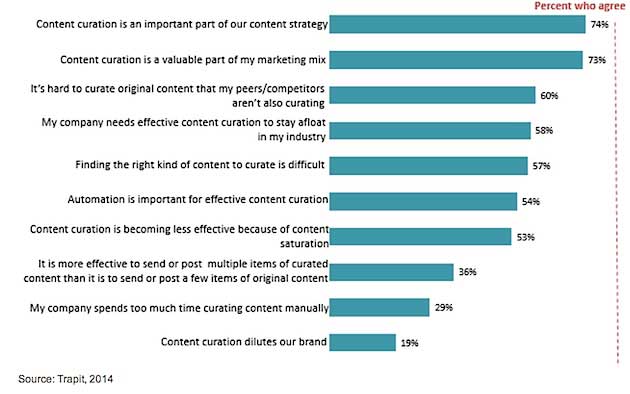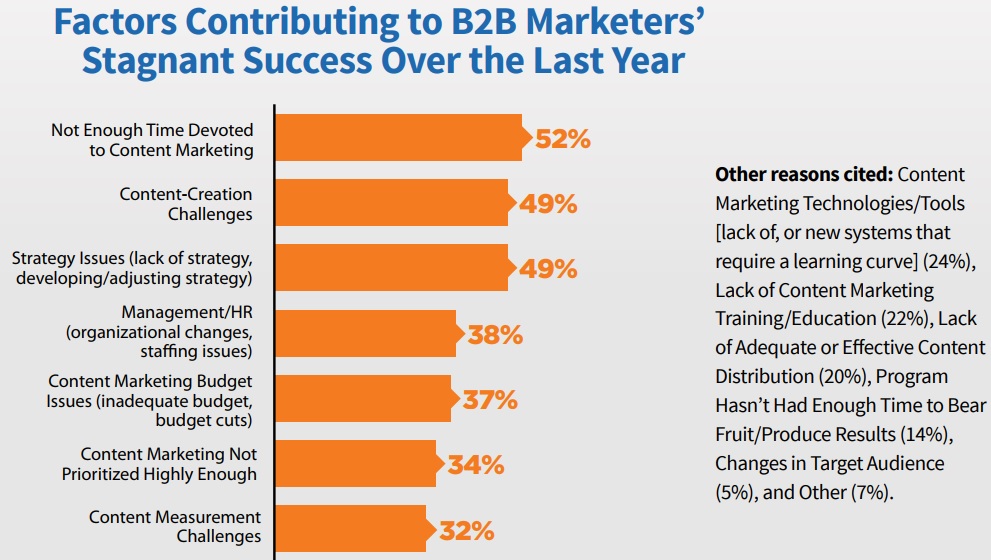If you’re investing a significant amount of time and money into your content operation and don’t have a content curation strategy to complement it, you’re missing out on some low-hanging fruit. Content curation goes hand in hand with an internal content creation operation, reinforcing positions and helping to educate your customers—even when you aren’t publishing new content.
Limiting the content that you share with your audience to the pieces that your brand produces only holds you back. And by giving, you also receive. Content curation can help brands in a variety of ways, including:
- Growing your following
- Developing new industry relationships
- Growing brand awareness
- Delivering a consistent stream of content
Companies that invest heavily in their content operation know the value of content curation. According to a survey by Trapit, 74% of marketers call content curation an important part of their content strategy and 73% say that it is a valuable part of their marketing mix. Curation should be a part of a larger strategy, meant to fill in gaps and leverage third-party content to bolster your own content creation efforts.

Source: Marketing Profs
Content curation is all about providing value to your audience and connecting them with the best information that your industry has to offer. Often, of course, that content comes from your company. At other times, it may come from another company in your industry. By positioning your brand as a source of information, you’ll grow your reputation as a thought leader and connect with larger audiences.
What Is Content Curation?
Content curation is the process of researching, organizing, and presenting third-party content in a meaningful way. It’s more than just sharing the content on your social media accounts: Your role as the curator is to provide context to the content that you share in order to make it valuable and worthwhile for your audience.
When you curate content, you mine industry blogs and other content sources for material that will be relevant to your audience. Finding and sharing the best content makes you a reliable source of information. But curation implies that the content has been vetted and found to be quality and relevant to your audience.
There are some key differences between content creation and content curation, although the two share many of the same benefits. Creating content is all about putting your expertise on display and delivering valuable material that your audience will appreciate and associate with your brand.
However, creating content can be a slow process. Many content operations aren’t able to produce as much new content as they’d like. Commenting on and sharing relevant industry materials not only helps you to connect with your audience but also makes you a known entity within your industry.
Why Curate Content?
So why curate content? Why not just double down on your content creation investment and share your own internally produced content? There are a few key benefits that come with curating content for your audience that make it worthwhile.
Alleviate the Content Creation Rush
When you weave curation into your content strategy, it can help to reduce some of the pressure that comes with a consistent content schedule. When you curate third-party content to share with your audience, you can fill minor gaps with curated content that your audience will still find relevant and helpful.
A Smaller Time Commitment
While it does take time to scout for new material to share, content curation is a much less time-intensive process than creating content.
Content creation is a serious challenge for B2B marketers. According to a study from the Content Marketing Institute, not having enough time to dedicate to content marketing was the single biggest challenge marketers faced that led to stagnant success. (Content creation challenges came in second.)
Content curation can help companies to reap the benefits of content creation with a far lesser investment of time and resources.

An Opportunity to Build Relationships
When you share content from individual thought leaders and brands, your brand is put on their radar, helping you to build relationships. The initial connections that you make from sharing third-party content can set your company up for more meaningful partner relationships in the future.
Paint a More Cohesive Picture for Your Audience
When you only share content that your own company has published, your audience misses out on different perspectives and interesting takes on hot industry topics that other companies and thought leaders are sharing.
Content curation allows you to leverage experts insights that touch on subjects outside of your brand’s direct area of expertise, which in turn helps to contextualize your key internal content within a larger industry discussion.
You’ll Be Seen as a Thought Leader
When you curate and share content and provide your own thoughts on the pieces that you share, you position yourself as a thought leader within your industry—either as a brand or as an individual.
Becoming a thought leader is a long and painstaking process. Giving opinions on third-party content will help you to facilitate a public discussion that will put your expertise on display in front of your audience.
How to Curate Content
Content curation is a process, and you may not gain traction right away. But over time, you’ll understand what content is connecting with your audience and learn how to present that content in a way that facilitates discussion.
Here are some tips to get started:
Read Everything
If you’re going to curate content, you have to make sure that you’re providing your audience with the best possible content. To do that, you have to know what is out there. Aim to read all of the major publications within your industry. Take note of which publications deliver consistently thought-provoking thought leadership in their content, and hone in on them in your content curation efforts.
It’s impossible to find the best content to share with your audience without first knowing what is out there. By reading as much as you possibly can, you’ll give yourself a better chance of finding the content that provides the most value to your audience.
Don’t Just Hit “Share”
Content curation isn’t just about hitting the “share” button and keeping an eye on your analytics. You should provide additional context or opinions with any article that you share. You could provide a competing opinion, help to explain a specific concept that the content covers, or simply explain why you thought the content was so great.
Know Your Sources
When you share content produced by a third party, you’re on a hook for the opinions and information shared within that content.
Knowing your sources (the publishers that produce the content) will help you narrow down the number of publications that you use to find content and weed out problematic content creators who share information that hasn’t been thoroughly fact-checked.
Remember, the content that you back will represent your brand to your audience.
Keep a Schedule
As with your internal content calendar, it’s important to maintain a clear and consistent schedule. Know when and how you would like to share the content that you curate. Will you deliver it through email? Social media? Both? Staying consistent will give your audience the opportunity to seek out your content where they have engaged with it previously.
Additionally, you can work curated content into your larger content schedule to ensure that you’re providing your audience with a consistent stream of valuable content.
Engage In Conversations Around Shared Content
We’ve said it several times in this article: Content curation isn’t just about sharing content with your followers. It’s about engaging in and facilitating a discussion around the pieces that you share.
When conversations break out around the curated content you’ve shared with your audience, don’t be afraid to jump in. Share your opinions. Answer questions that they might have. Direct them toward the creator of the content.
Use Content Aggregators
Content aggregators are the content curators best friend. They help you to sift through the tens of thousands of pieces of content published in your industry daily and hone in on the ones that will provide the most value to your audience.
Content aggregators can be industry-specific or more general. Here are a few of the more popular content aggregation websites you can try:
These are just a few of the many examples of content aggregators in operation today. Finding one that deals specifically with your industry and subjects that are relevant to your it can be very helpful.
Setup RSS Feeds & Google Alerts
Alternatively, you can also set up your own content aggregators to help you identify useful industry content for your curation efforts.
Setting up RSS feeds is perhaps the simplest method. An RSS feed is simply a list of updates from websites that you subscribe to. They provide a simple and effective way to keep up with the latest content published on your favorite website. Feedly is a free solution that allows you to set up RSS feeds. Feedly makes it easy to follow industry publications and identify the most popular posts among your followed publications.
Additionally, you can create Google Alerts that will send you an email when content using specific key phrases is published. Setting Alerts for specific industry keywords can be a great way to discover new publications and keep a close eye on industry subjects that are especially relevant to your audience.
Lean on Tools
Content curation is very difficult to do by hand. There are many tools out there that can assist in the process of finding and evaluating content that comes through your feeds.
Focus on Value in Curation
Content curation should be part of any well-rounded content operation. Like any piece of content that you create, your biggest goal with content curation should be to educate and provide value to your audience. Share pieces that cover the subjects that they’re interested in and facilitate discussions around those topics. In doing so consistently, you’ll help to secure your position as a leading industry thought leader.


